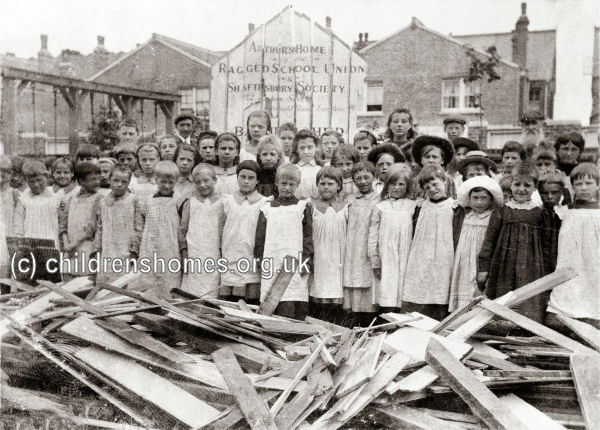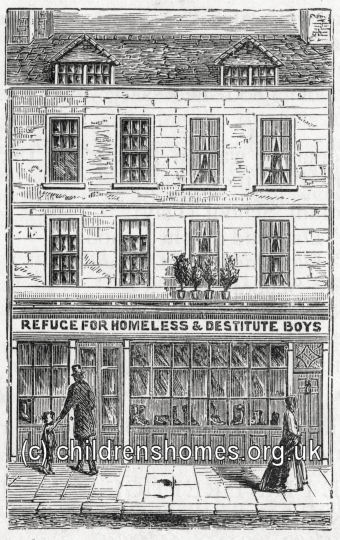The Shaftesbury Homes and Arethusa
A Permanent Home
In an effort to rationalise its operations, the Committee launched an appeal for funds to provide permanent premises. An ideal building was found at the corner of Broad Street and George Street, which later adopted the address of 19 Broad Street. Originally used as a 'gin palace', it comprised four storeys plus a basement, with plenty of space for separate schoolrooms for boys, girls and infants, plus residential refuge accommodation for up to 100 children. The purchase price of £1,800 was raised partly through donations and partly through a mortgage. A grand opening took place on June 23rd, 1852, with a celebratory feast of roast beef and plum pudding for 300 pupils. On the same day, Lord Ashley chaired a public meeting to raise funds for the School.
In 1853, the old Neal's Yard premises were converted for use as a night refuge for homeless boys who were fed and given a bed but had to fend for themselves in the daytime. Those who demonstrated a willingness to learn were transferred to Broad Street when places became available. Reflecting the broadening of its scope, the organisation's title now became The St Giles and St George, Bloomsbury, Refuge for Destitute Children and Ragged and Industrial Schools. From 1855, as a result of growing concern about both boys and girls residing at Broad Street, the accommodation was used only for girls. Premises were then rented at 17 Arthur Street, St Giles, where the boys resided and received their industrial training, but coming to Broad Street for their other lessons. In May, 1860, forty of the older girls were moved to new premises at Acton, with the girls' refuge at Broad Street acting as its reception home. Both establishments were under the matronship of Mrs Edmonds. The Acton home provided a laundry service for all the Society's other establishments. In 1866, the end of the Acton Home's lease forced its removal to temporary accommodation at Greville Road, Kilburn, with a move to permanent premises at Ealing being made in July, 1867.

Children at the rear of the Arthur Street Home, date unknown. © Peter Higginbotham
The Boys' Refuge at Arthur Street, which was rather small and inconvenient for its purpose, was transferred in 1857 to new premises — a former coach factory at 8 Great Queen Street. The sum of £850 needed to alter and equip the building included a grant from the Ragged School Union, together with funds raised by the former Lord Ashley, who in 1851 had succeeded to the title of the Earl of Shaftesbury.

The Great Queen Street Refuge, c.1857. © Peter Higginbotham
The increasing workload undertaken by William Williams — still then working on an unpaid basis — prompted the Committee in 1857 to create a full-time post of 'Assistant to the Secretary', to which William Chappell was appointed. Despite this, Williams decided to give up his employment as a solicitor's clerk so that he could devote even more time to his work for the Society. After his plans to generate a income from occasional private work were unsuccessful, the Committee decided — without consulting Williams — to create a permanent, full-time, salaried position for him. This he reluctantly accepted, but at a salary of only £150 a year, rather less then the Committee had originally offered, and also less than his clerk's salary.
In 1871, the Society began an experiment in the shape of the Newsboys' Home at 80 Gray's Inn Road. The Home, which was superintended by a married couple, offered modestly priced bed and board to boys selling newspapers and other articles on the city's streets. In 1875, the establishment began to also offer accommodation to boys starting work in London and so was renamed the Home for Working Boys.
Lord Shaftesbury, who had become the Society's Patron in 1866, and its President in 1874, died on October 1st, 1885. He was succeeded as President by the Earl of Jersey, one of the Society's Vice-Presidents. One of Lord Jersey's early initiatives, by way of honouring Shaftesbury's memory, was the setting up in 1886 of 'The Ashley Club', a room set aside at the Great Queen Street premises where young men. who had passed through one of the Society's schools or refuges, could come and socialise, read newspapers, play board games, and relax. Despite an enthusiastic start, interest in the Club soon waned and it was discontinued within a couple of years.
Except where indicated, this page () © Peter Higginbotham. Contents may not be reproduced without permission.


